The benefits of building with wood: environmentally-friendly, reusable and light
Timber-based construction is on the rise again. Wood is well suited for industrial processing as it captures CO2 and is easy to recycle. Timber construction is currently more expensive, but it is expected to become much more competitive over the next few years thanks to economies of scale
Construction companies, like other European companies, are working to reduce CO2 emissions and to do business in a circular way where possible. Bio-based building materials such as flax, reed, cork, straw, hemp and sheep's wool are in the spotlight. Building with wood is also increasingly seen as an option to replace the use of energy-intensive concrete. In Scandinavian countries such as Sweden and Finland, for example, much construction traditionally uses wood. In this article, we examine whether timber-based construction is a viable alternative to other building materials such as concrete.
Relatively high use of wood in Scandinavian countries
Share of value of wood (products) in total construction production, 2018
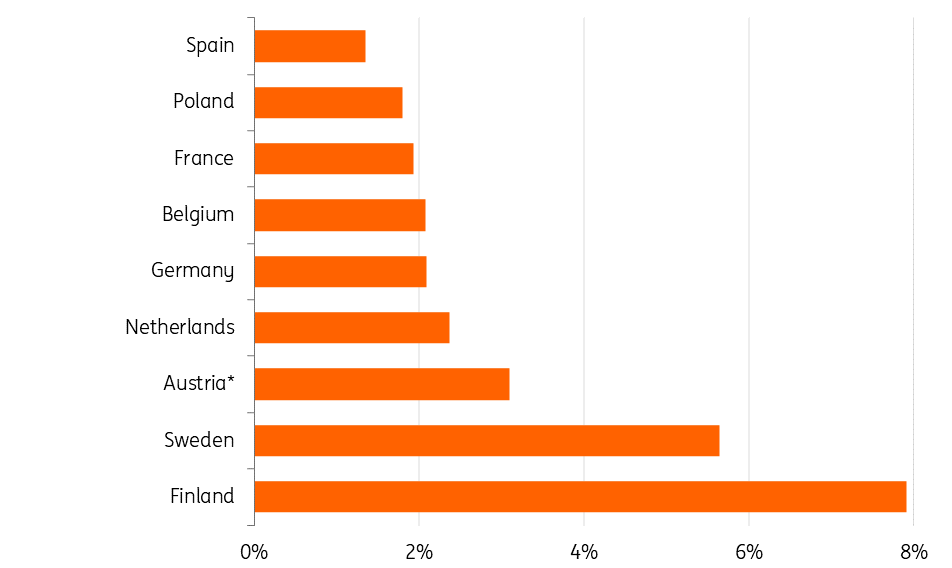
What is timber construction?
The use of wood as a building material dates back centuries
Before the industrial revolution, wood was the most important building material. During the last two centuries, however, wood has often been replaced by concrete, bricks, steel and also plastics. However, these materials have a significant negative impact on the environment. To prevent this, more construction companies are considering using bio-based materials such as wood. Of course, it is important that the wood used comes from a sustainably managed source. The two best-known quality marks are FSC and PEFC.
The options offered by timber construction
Wood is often used in the finishing details, like doors and window frames. However, wood can be used for so much more – entire structures can be built with wood, meaning that concrete can be replaced. This can be done with timber frame construction or with timber products such as CLT (Cross Laminated Timber). CLT is a type of huge, plywood sheet that matches other building materials in terms of strength and durability but has many other advantages (more on this below). Since the wooden structure is not exposed to the weather, many European wood species such as softwood can be used for this purpose, removing the need to use tropical hardwood.
Where is the wood sourced from?
The wood used in Europe is sourced from many different countries. This spread is a positive factor as it ensures greater security of supply. Germany and Sweden are the largest exporters to the Netherlands, Belgium and Poland, among others. Wood was also imported from Russia in the past. Now that these imports from Russia have ceased due to the war in Ukraine, this change can be absorbed relatively easily from other import markets. However, declining supply due to the loss of Russian timber production is causing price increases in the world timber market.
Origin of imported assorted wood
Origin of imports of wood and wood products by different European countries, 2021
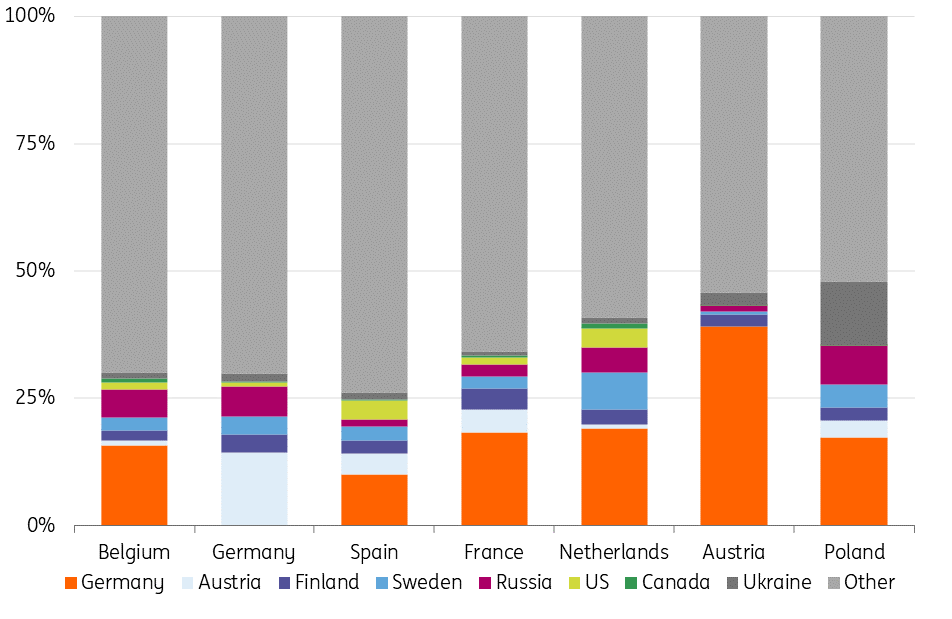
Increasing demand for timber construction
Governments are striving to use more bio-based building materials, including wood. As an example, France has recently introduced a new law that requires half of the materials used in public buildings to be wood or other bio-based materials. Build-in-Wood is a project funded by the European Union with the aim of significantly increasing the use of wood as a building material. There are seven Early Adopter Cities: Trondheim (Norway), Trento (Italy), Innsbruck (Austria), Copenhagen (Denmark), London (UK), Brașov (Romania) and Amsterdam (The Netherlands). As an example, the Amsterdam metropolitan region in the Netherlands has agreed in a covenant to use wood as the main building material for 20% of new homes built by 2025. Amsterdam is also the first municipality in the Netherlands to plan an all-wood district, with the construction of 700 new wooden houses in the city's Mandel Park (Amsterdam-Zuidoost) scheduled for 2025.
Several large European construction companies are committed to using more wood as a building material in the coming years.
BAM, one of the largest construction companies in the Netherlands, started building its own factory for wooden houses at the end of 2021. Initially, these will be ground-floor homes, followed by high-rise buildings. BAM wants to produce 300 wood-frame homes from 2023 and increase this figure to 600 in 2024 and 1,000 from 2025. It will also need to produce wooden façade elements for 1,200 homes. BAM wants to manage and further industrialise the entire construction process itself, rather than only taking control as a contractor. The basic principles are sustainable, healthy homes built according to circular principles, which is in line with BAM's strategy of ‘Building a sustainable tomorrow'.
To reduce its environmental footprint, the French Bouygues Construction firm aims to reduce its greenhouse emissions by 30% by 2030. Additionally, the company has the strategic target of constructing 30% of its building projects in Europe in timber by the same year, as well as contributing to sustainable forestry management. As part of the Bouygues WeWood initiative, more than 160 timber construction projects were completed since 2005.
Arbonis, a subsidiary of French construction company Vinci, specialises in timber design and construction for all types of buildings. Arbonis is helping Vinci to meet its environmental performance objectives. It took part in the Treed It sustainable city demonstrator in Marne-la-Vallée, to the east of Paris. This building project included an eleven-floor, 37-metre-high tower with a wooden framework.
What are the advantages of timber construction?
Timber construction offers several advantages over traditional construction:
CO2 capture instead of CO2 emissions
The concrete, cement and brick industries use a great deal of energy in their production processes, emitting large quantities of CO2. Per euro of production value, the sector's energy consumption is many times higher than in the wood industry. This means that replacing concrete with wood can drastically reduce CO2 emissions resulting from building production.
Wood industry uses a relatively small amount of energy
Energy consumption (gas, oil, electricity and coal) in terajoules per €1 million of production in Germany, 2019
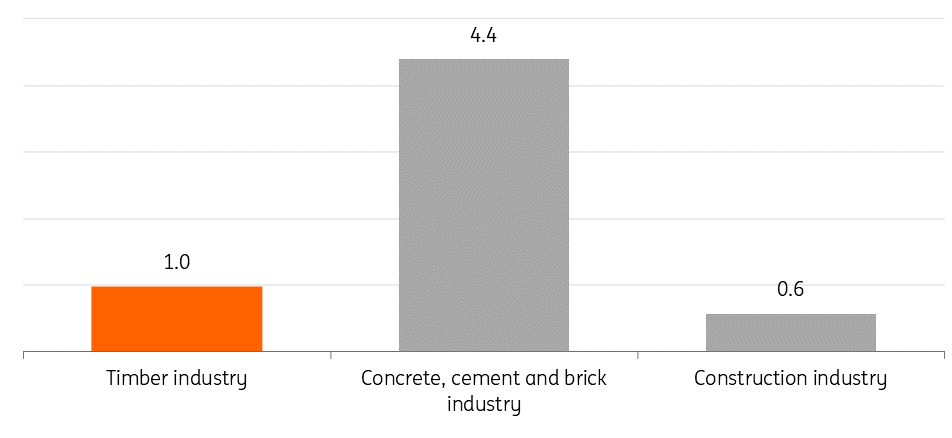
Constructing 100,000 wooden homes offsets one year’s worth of CO2 emissions from gas consumption in a medium-sized European city
Using wood instead of concrete reduces energy consumption as well as CO2 emissions in the production process. When trees grow, CO2 is also stored in the wood. One m3 of wood contains over 750 kg of CO2 (depending on the type of wood). A wooden single-family house requires (at least) 30 m3 of wood. If 100,000 homes (less than 10% of all new construction in the EU) are eventually built of wood in the EU, approximately 0.45 megatons of CO2 will be sequestered in the homes. This corresponds to the annual gas consumption of almost 700,000 households that heat their homes with a central heating boiler, which is comparable to a medium-sized European city. This does mean that the trees have been cut down and therefore no longer absorb CO2. That is why it is important to only use wood from sustainably managed forests, so that the forest area does not decrease and newly planted trees can absorb CO2. Wooden houses do not absorb new CO2, but living trees do.
Timber construction has negative CO2 emissions
CO2/m3 emissions CLT (Cross Laminated Timber) wood harvesting, manufacturing and construction process
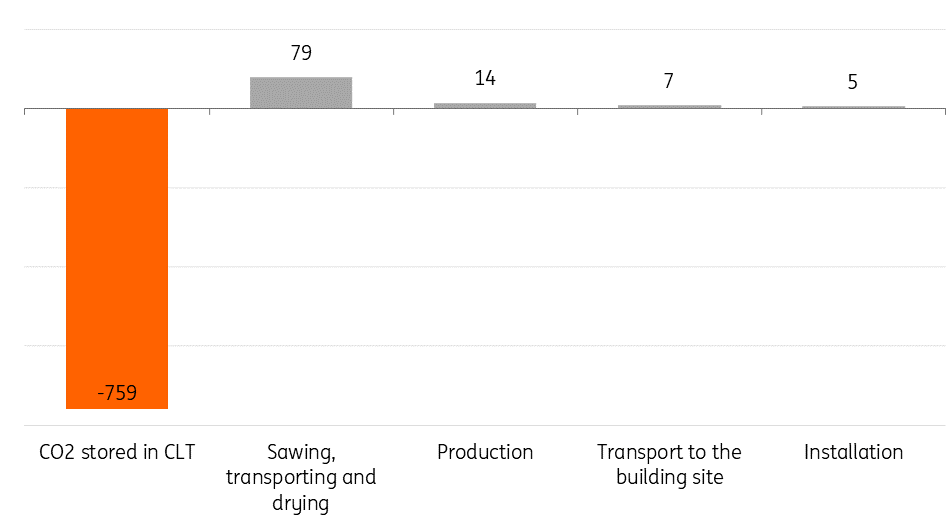
Other wood benefits
Wood is much lighter than concrete
Another advantage of wood as a building material is that it is much lighter than concrete. Wood weighs only about a fifth of the weight of the same volume of concrete and does not need to be dried as part of the production process like concrete. This makes it cheaper and easier to transport and means lighter foundations can be used. As wood is lighter, existing buildings can also be extended more easily by one or more floors, which can increase an existing building's floor space and yield.
Ideal for industrial construction processes and lower upfront investments
To limit staff shortages and rising construction costs, the focus is increasingly turning towards the industrialisation of the construction process. By this, we mean the replacement of manual work by machines and robots. Wood is easy to process in an industrial process (see industrialisation in construction) because it is lighter. This means that large, prefabricated elements are easier to transport, can be processed with a greater degree of precision and are easier to connect.
Easier reuse
Wood can serve as a structure in a building for more than 100 years. After that, reuse (circular or otherwise) is quite possible. In particular, large wooden elements can be reused. After several reuses, it can also be processed into other wood applications (e.g. chipboard). Lastly, it can be burned as biomass. Unfortunately, the stored CO2 will then be released after many years.
A more pleasant indoor climate and less susceptible to earthquakes
Wood ensures a more pleasant indoor climate because it regulates moisture and heat, creating a comfortable and stable indoor climate. The acoustics are also often better in a wooden building, as there is less reverberation. Additionally, wood can be used to build structures that can better withstand earthquakes, since it can absorb shocks better than bricks and concrete.
What are barriers to timber construction?
Timber construction is also subject to a number of barriers:
Timber construction requires new investments
Building with concrete, bricks and cement became part of the construction industry's ‘genes’ after the first industrial revolution. A shift to timber construction would require new investments in knowledge and production processes. This is costly and time-consuming.
The timber price is more volatile...
Timber prices react relatively quickly to changes in the market. If stocks of suppliers and wooden building materials dwindle, this leads to increases in the price of wood within one to two months. The (global) markets for this type of material are very competitive, so changing purchase prices are quickly passed on.
...when compared with the price of concrete
Building materials such as concrete and cement are heavy and voluminous. For this reason, they are often traded on relatively small local markets resulting in less competition. This gives suppliers of these products more market power, which usually results in both higher prices and lower price volatility. They do not have to pass on price reductions of raw materials or energy costs directly because of the reduced competition. However, they cannot directly pass on price increases in inputs (e.g. energy costs) because they have already been able to set their prices at a relatively high level because of the more limited competition. As a result, the output prices of these products fall or rise at a slower rate compared to wood. This is one of the reasons why the current prices of cement, concrete and bricks have not risen as much as the price of wood. This is despite the high energy prices that are an important part of the cost price of these materials.
Prices for timber products are more volatile than those for concrete, cement and bricks
Monthly price trend compared with the previous year, European Union
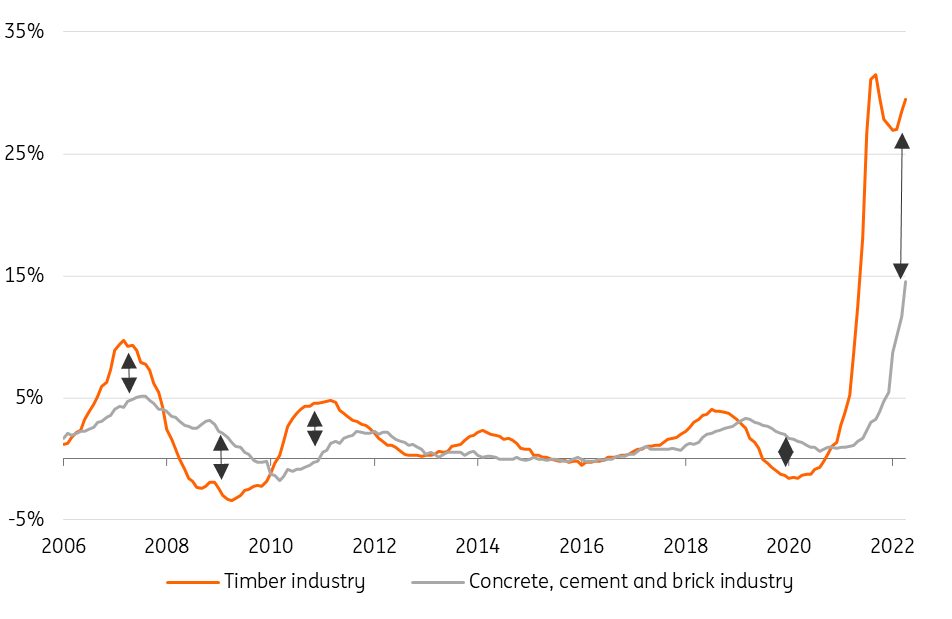
Fire hazard and sufficient wood production myths
A number of myths about the use of wood still persist to this day. As an example, while it is claimed that wood is a fire hazard, solid wood does not burn easily. In addition, wood is much more predictable when subjected to a fire in comparison to other traditional building materials. Furthermore, the structural capacity of wood is also maintained over a longer period of time during a fire. Fire safety requirements can therefore easily be met through the use of wood.
Another consideration is that there is not enough wood in Europe to make large-scale timber construction possible. Forests account for almost 40% of the land area in the EU, and this proportion has been increasing for many years. In the 2009-18 period, the surface area of forests in the EU increased by 15 million hectares. If we assume an annual yield of 2.5 m3 of wood per hectare (as is currently the case in the EU) and 30 m3 of wood per new home, more than one million homes can be built in the European Union annually from this new forest expansion alone. This also applies if done in a sustainable manner. In addition, sustainable logging from existing forests can also be further increased. Naturally, it is important that this is done sustainably – just as you cannot just go somewhere to start digging for sand and gravel for concrete.
The amount of forest in Europe is increasing
Percentage of forest per country
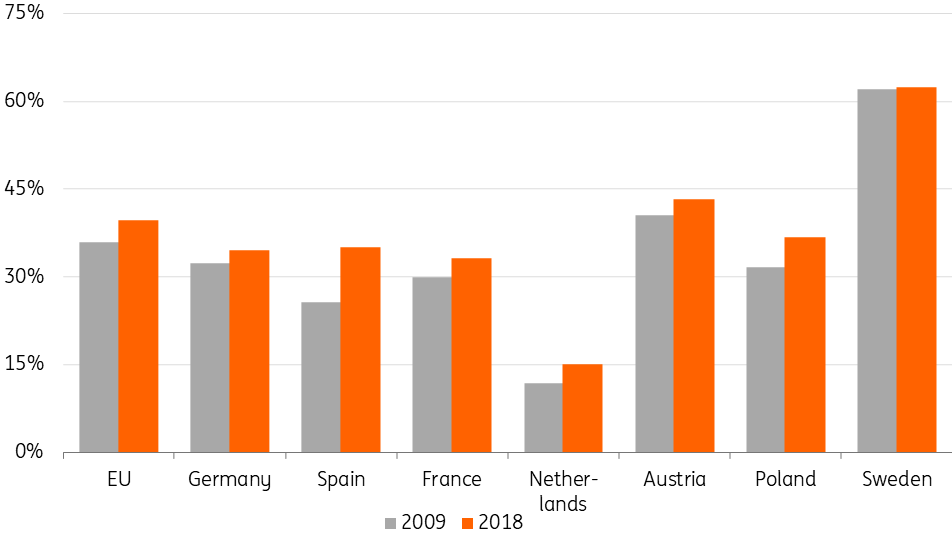
Building with wood is (currently) more expensive
New investments and the cost of wood mean that timber construction is still a little more expensive than concrete, cement and bricks. Based on discussions with industry specialists and various literature sources, we estimate that the costs are 5-10% higher. This can vary from building to building. However, there are many reasons to believe that timber construction could become relatively cheaper. If more is built with wood, this can create scale effects, causing the price per home to fall. In addition, the price of producing energy-intensive building materials may rise further in the coming years due to permanently increased energy prices and more expensive CO2 emission rights. This would make traditional building materials such as concrete and bricks relatively more expensive compared with wood.
Timber construction still 5-10% more expensive
Costs of timber construction vs concrete

What to do as a contractor?
Evolution of timber construction instead of revolution
Thanks to its great advantages, timber construction is bound to increase in the coming years. A growing number of municipalities or other authorities, project developers and property investors will set more targets, as the Amsterdam Metropolitan Region has done for timber construction. However, this does not mean that the entire construction market will reorientate in a few years. We expect that evolution will take place before a revolution does. The Amsterdam metropolitan region, for example, is aiming for 20% timber construction by 2025. However, it will take many years before this percentage is reached in other European cities or regions.
How should construction companies adapt to this new trend?
Timber construction is definitely a trend that construction companies should take into account. In recent years, however, many construction companies have invested in the industrialisation of their building process – which is still primarily based on concrete. There will certainly be plenty of demand for concrete houses in the years to come. Switching to wood now would lead to ‘sunk costs’ for these construction companies, which can then no longer be recouped. For companies that have not yet invested in industrialisation, building with wood is certainly an opportunity. They could respond to this new trend that will see a rise in demand in the coming years. It is to their advantage that the industrialisation of timber construction, as mentioned earlier, requires lower investments because timber is much lighter than concrete. The machinery used can therefore be lighter. This lower upfront investment is an advantage in the volatile construction sector. If a factory that makes wooden homes cannot operate at full capacity due to lower demand, the fixed costs that need to be covered will also be lower.
This publication has been prepared by ING solely for information purposes irrespective of a particular user's means, financial situation or investment objectives. The information does not constitute investment recommendation, and nor is it investment, legal or tax advice or an offer or solicitation to purchase or sell any financial instrument. Read more
Download
Download article